Designing a beautiful walkway for your home can greatly enhance its curb appeal and overall aesthetic. A well-designed walkway not only provides a functional path to your front door, but it also adds charm and visual interest to your property. Whether you have a small space or a sprawling front yard, there are essential tips and considerations to keep in mind when designing your walkway.
From selecting the right materials to incorporating landscaping elements, this article will provide you with 7 essential tips to help you create a beautiful walkway that welcomes guests and enhances the overall beauty of your home.
1. Start With A Plan
Before you start digging and laying down materials for your walkway, it’s crucial to have a well-thought-out plan in place. Here are some important factors to consider when planning your walkway design:
Determine the purpose of your walkway. Is it purely functional, providing a path from the driveway to the front door? Or do you want it to serve as a welcoming entrance, adding visual interest and charm to your home? Understanding the purpose will guide your design choices.
Consider the most convenient and logical path from the driveway or street to the front door. Take into account existing landscape features, such as trees and gardens, and make sure the walkway integrates seamlessly with the overall layout of your property.
Decide on the width and shape of your walkway based on practicality and aesthetic preferences. A wider walkway allows for comfortable passage of multiple people side by side, while a narrower path may be suitable for a more intimate and secluded feel.
Explore different materials available for walkways, such as flagstone, pavers, concrete, gravel, or brick. Consider factors like durability, maintenance, and how well the materials complement the architectural style of your home.
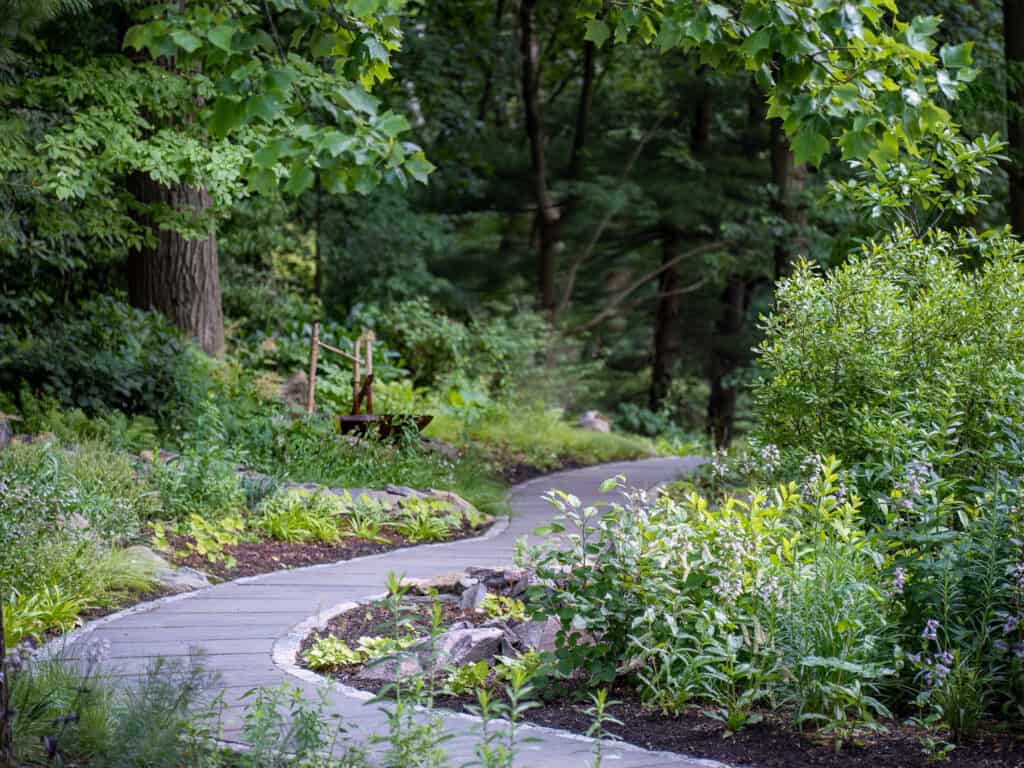
Incorporate lighting elements into your walkway design to enhance safety and create a magical ambiance. Consider options like solar-powered lights, lanterns, or embedded lighting fixtures that illuminate the path and highlight landscaping features.
Think about how your walkway can seamlessly blend with the surrounding landscape. Consider incorporating garden beds, flower borders, and shrubs to add color and texture. Balance the hardscape elements of the walkway with softscape elements to create a harmonious and inviting atmosphere.
Proper drainage is essential to prevent water pooling and damage to your walkway. Plan for suitable slopes and consider using permeable materials that allow water to soak into the ground.
Consider the level of maintenance required for your chosen materials and design elements. Choose materials and landscaping features that align with your maintenance preferences and capabilities.
Set a budget for your walkway project and prioritize your design choices accordingly. Research the costs of materials, labor, and any additional features you wish to include to ensure they align with your budget.
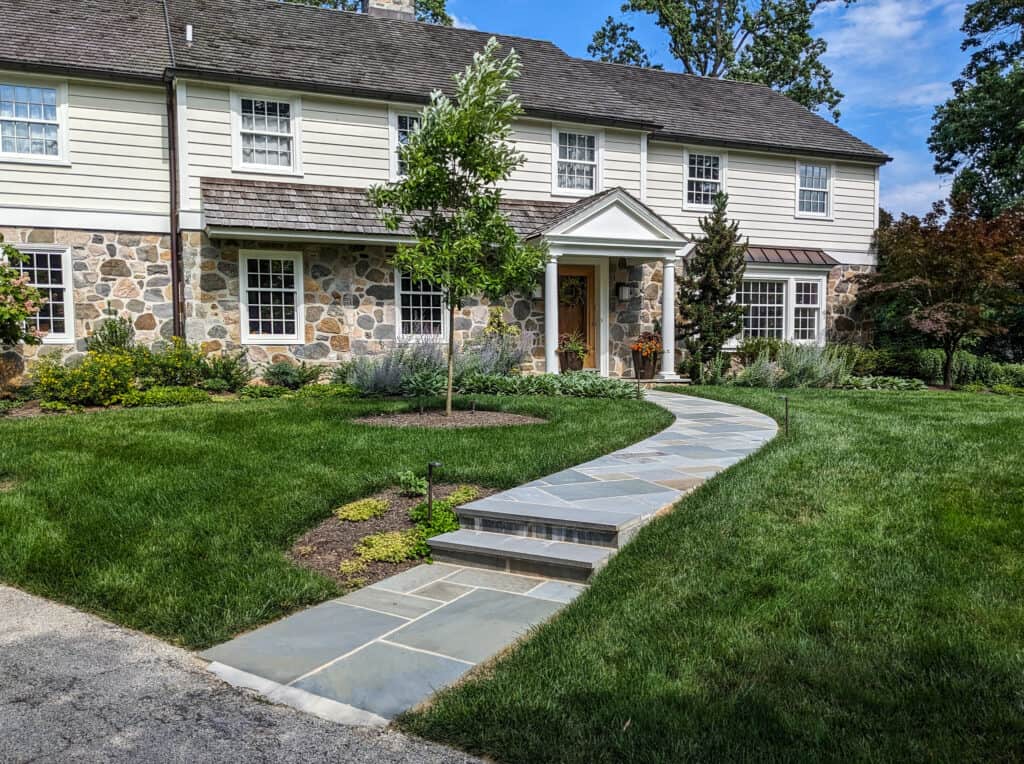
2. Consider Functionality and Safety
When designing a walkway for your home, it is important to prioritize both functionality and safety. Here are some essential tips to consider in order to create a walkway that is not only beautiful but also practical and safe:
- Clear path: Ensure that your walkway provides a clear and direct path from the driveway or street to the front door. It should be easily identifiable and free from obstacles such as overgrown plants or clutter.
- Width: The width of your walkway should be wide enough to allow for the comfortable passage of people walking side by side. A minimum width of 4 feet is recommended, but you may want to consider a wider path if you have space and anticipate heavy foot traffic.
- Surface material: Choose a surface material that is slip-resistant and provides good traction, especially during wet or icy conditions. Avoid using smooth stones or materials that can become slippery when wet.
- Lighting: Incorporate lighting elements along your walkway to enhance safety and visibility, particularly during the evening or night. Consider options such as solar-powered lights or motion-sensor lights that illuminate the path and make it easier to navigate.
- Handrails: If your walkway includes steps or slopes, consider installing handrails for added stability and support. This is particularly important if you have elderly or mobility-impaired individuals in your household or frequently receive visitors with accessibility needs.
- Clear markings: Make sure to provide clear markings or boundaries along your walkway to indicate its edges. This could be achieved through the use of low-level lighting, contrasting materials, or physical barriers such as hedges or low fences.
- Landscaping considerations: Incorporate landscaping elements that not only enhance the aesthetics of your walkway but also promote safety. Avoid planting thorny or prickly plants along the path, as they can pose a hazard to passersby. Regularly trim any overhanging branches that could obstruct the walkway.
- Accessibility: If you have family members or visitors with accessibility needs, ensure that your walkway is designed to accommodate them. Consider installing ramps or gradually sloping sections to provide easy access for individuals with mobility devices or strollers.
- Maintenance: Regularly inspect and maintain your walkway to ensure that it remains safe and functional. Repair any cracks or uneven surfaces, remove debris, and ensure that lighting fixtures are in proper working order.
- Seasonal considerations: Take into account seasonal factors such as snow removal or ice prevention. Install heating elements or provide a designated path for snow removal to prevent slippery conditions during winter months.
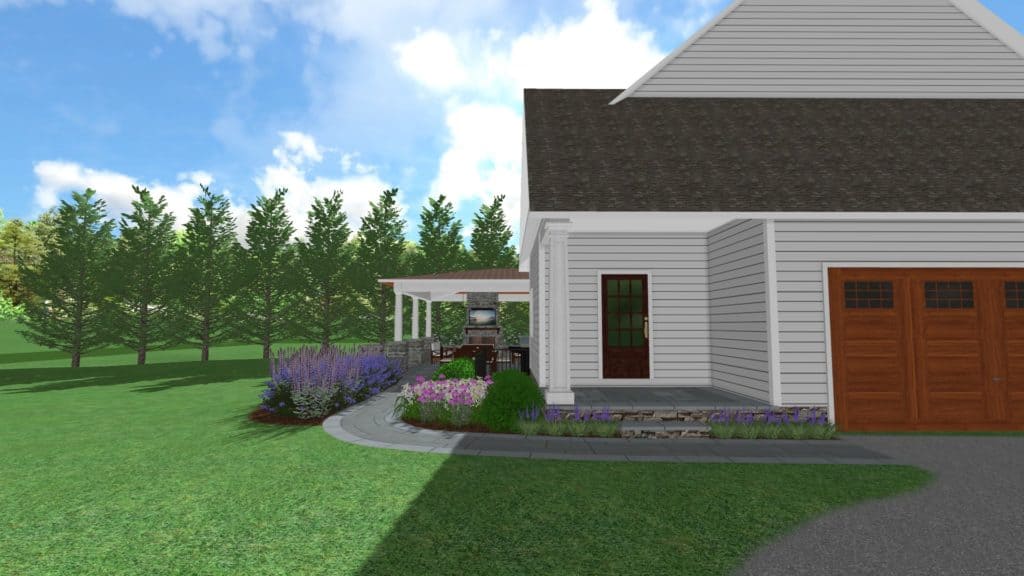
3. Choose the Right Materials
Selecting the right materials for your walkway is crucial in achieving both functionality and aesthetics. Here are some essential tips to consider when choosing materials for your walkway:
- Durability: Opt for materials that are durable and can withstand foot traffic, weather conditions, and regular maintenance. Materials such as concrete, pavers, natural stone, and brick are known for their durability and longevity.
- Slip-resistance: Safety should be a top priority when selecting materials for your walkway. Look for materials that have a textured or rough surface to provide good traction, especially during wet or icy conditions. Avoid materials that are smooth or glossy, as they can become slippery when wet.
- Aesthetics: Consider the overall style and theme of your home when choosing materials for your walkway. Select materials that complement the architecture and landscaping of your property. For example, if you have a rustic or traditional home, natural stone or brick may be a suitable choice. If you have a modern or contemporary home, concrete or pavers in clean, sleek designs may be more appropriate.
- Maintenance: Evaluate the level of maintenance required for each type of material. Some materials may require regular sealing, cleaning, or repairs, while others may be relatively low maintenance. Consider your willingness to invest time and effort into maintaining the appearance and condition of your walkway.
- Cost: Set a budget for your walkway project and choose materials that fit within your budget. Keep in mind that certain materials may have higher upfront costs but can save money in the long run due to their durability and longevity. Consider the long-term value and return on investment of the materials you choose.
- Climate suitability: Consider the climate and weather conditions in your area when selecting materials. Some materials may be more prone to cracking, fading, or deteriorating in certain climates. Consult with local experts or professionals to determine which materials are best suited for your specific climate.
- Eco-friendliness: If environmental sustainability is important to you, consider choosing materials that are eco-friendly and have a low environmental impact. Look for materials that are locally sourced, recycled, or have sustainable production practices.
- Accessibility: If you have family members or visitors with accessibility needs, consider materials that provide a smooth and level surface for easy mobility. Avoid materials with uneven surfaces or large gaps that can be challenging for individuals using mobility devices or strollers.
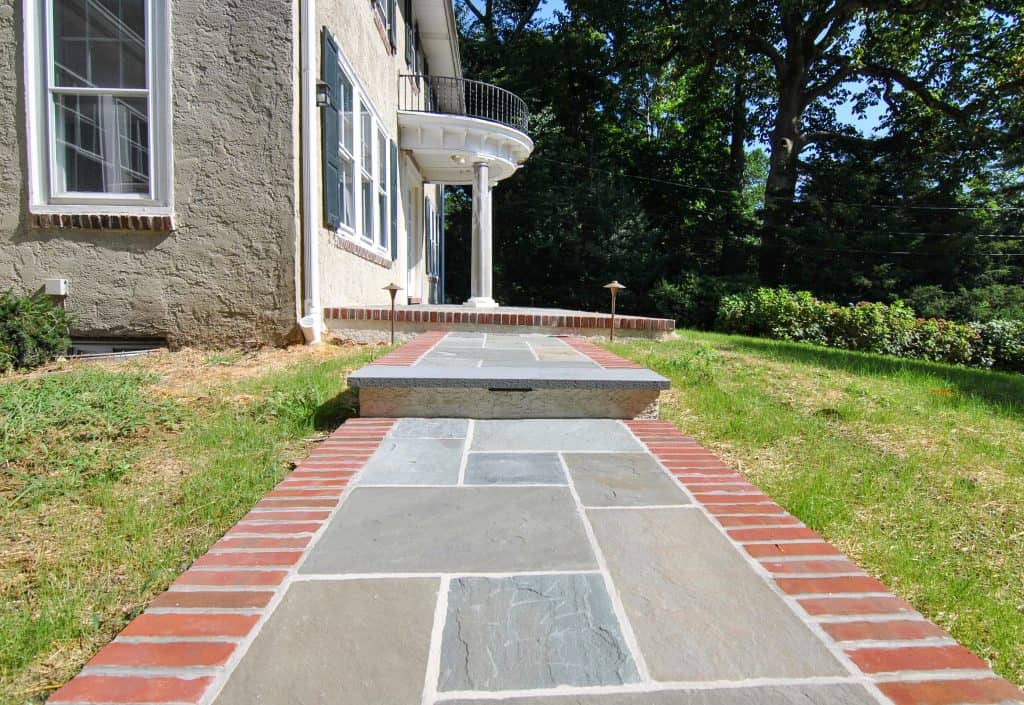
4. Create a Cohesive and Aesthetically Pleasing Design
Once you have chosen the right materials for your walkway, it’s time to focus on the design aspect. Creating a cohesive and aesthetically pleasing design will enhance the overall look and feel of your home’s entrance. Here are five essential tips to keep in mind when designing your walkway:
- Consider the architecture: Take into account the architectural style of your home when designing your walkway. The design should complement the existing features and overall aesthetics of your property. For example, if you have a traditional-style home, a curved or winding path with softer edges may be more suitable. On the other hand, if you have a modern home, a straight, clean-lined path may be a better choice.
- Plan the layout: Before starting the construction process, take the time to carefully plan the layout of your walkway. Consider the flow of foot traffic and any potential obstacles or landscaping features that you want to incorporate along the path. A well-planned layout will ensure that the walkway is functional, visually appealing, and seamlessly integrated into your outdoor space.
- Create focal points: Incorporate focal points along your walkway to add visual interest and break up the monotony. This could be done through the use of decorative elements such as statues, planters, or unique lighting fixtures. Focal points not only draw attention but also provide a sense of direction and purpose to the overall design.
- Use landscaping to enhance the design: Incorporating landscaping elements such as plants, flowers, and shrubs along the walkway can greatly enhance its visual appeal. Choose plants that complement the overall theme and style of your home. Consider factors such as color, texture, and height to create a cohesive and harmonious look. Additionally, well-placed lighting can accentuate the landscaping features and create a welcoming ambiance.
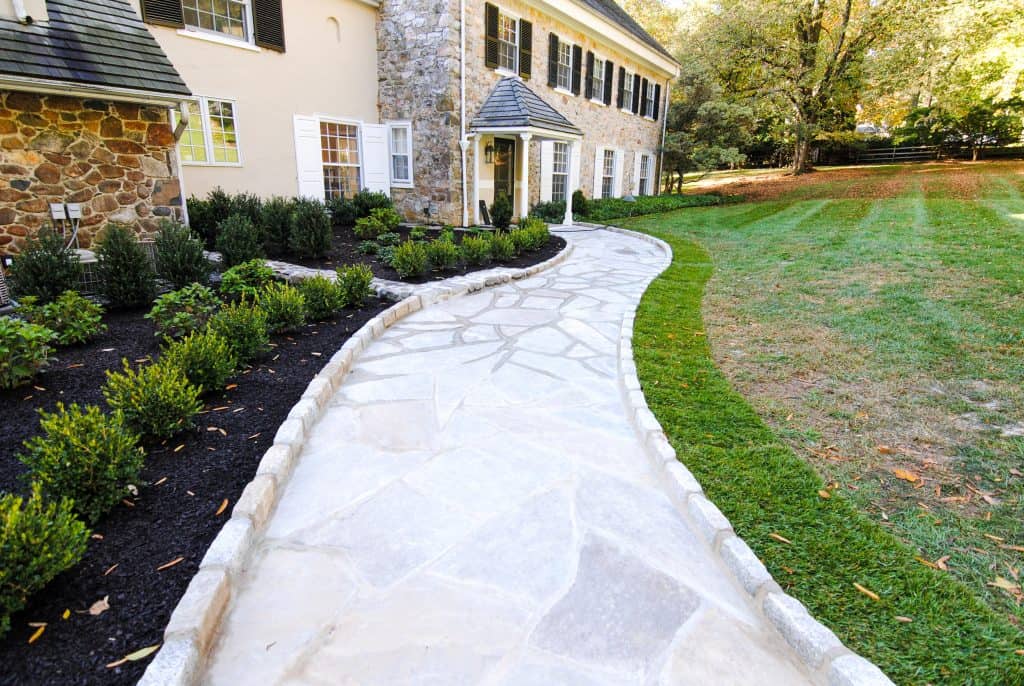
5. Incorporate Landscaping Elements
One of the key aspects of designing a beautiful walkway for your home is incorporating landscaping elements along the path. Landscaping not only enhances the overall aesthetics of the walkway but also creates a harmonious and inviting atmosphere. Here are some essential tips for incorporating landscaping elements into your walkway design:
- Choose plants that complement the overall theme: When selecting plants for your walkway, consider the style and theme of your home. Choose plants that complement the architectural features and color scheme of your property. For example, if you have a modern-style home, opt for sleek and minimalistic plant varieties. On the other hand, if you have a more rustic or cottage-style home, consider using plants with a softer and more organic appearance.
- Consider color, texture, and height: Pay attention to the color, texture, and height of the plants you choose. Use a mix of different plant varieties to create visual interest and depth. Consider incorporating plants with varying foliage colors, such as vibrant flowers or lush greenery, to add pops of color along the walkway. Additionally, mix plants with different textures and heights to create a visually dynamic and layered effect.
- Use containers and planters: Incorporating containers and planters along the walkway is a great way to add versatility and flexibility to your landscaping design. Use decorative pots or planters to showcase your favorite blooms and greenery. These containers can be strategically placed along the walkway to create focal points and break up the monotony of the path.
- Install lighting fixtures: Well-placed lighting fixtures can dramatically enhance the visual appeal of your landscaping elements. Consider installing path lights or spotlights to highlight specific plants or architectural features. Lighting not only adds a touch of elegance but also ensures safety and visibility along the walkway, especially during the evening hours.
- Create a sense of rhythm and repetition: To create a cohesive and harmonious look, use a sense of rhythm and repetition in your landscaping design. Repeat certain plant varieties or colors at regular intervals along the walkway to create a structured and organized appearance. This repetition creates a sense of unity and balance in the overall design.
- Maintain and prune regularly: Once you have incorporated landscaping elements into your walkway, it is important to maintain them regularly. Prune shrubs and plants to keep them in shape and prevent overgrowth. Remove any dead or damaged foliage to maintain a neat and tidy appearance. Regular maintenance will ensure that your landscaping elements continue to enhance the overall beauty of your walkway.
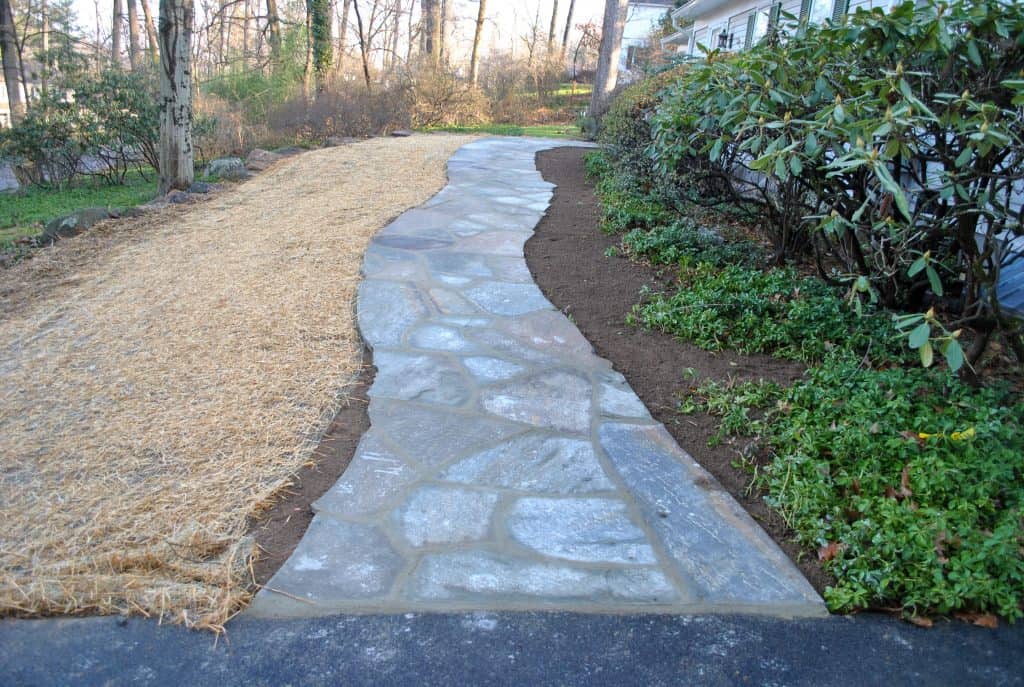
6. Consider Lighting Options
In addition to landscaping elements, proper lighting is essential to designing a beautiful walkway to your home. It not only enhances the aesthetic appeal but also provides safety and visibility, especially during the evening hours. Here are some important considerations when it comes to lighting your walkway:
- Choose the right type of lighting fixtures: There are various types of lighting fixtures available, such as path lights, spotlights, and uplights. Path lights are ideal for illuminating the walkway itself, while spotlights can be used to highlight specific architectural features or landscaping elements. Uplights can be placed at the base of trees or other tall plants to create a dramatic effect. Consider the overall design and layout of your walkway to determine which type of lighting fixtures will work best.
- Determine the ideal placement of lighting fixtures: The placement of lighting fixtures along your walkway is crucial to creating a visually appealing and functional lighting design. Path lights should be positioned at regular intervals along the sides of the walkway to provide an even and consistent illumination. Spotlight fixtures can be strategically placed to accentuate certain areas or focal points. Experiment with different placements to find the most flattering and dramatic lighting effect.
- Consider the intensity and color of lighting: The intensity of the lighting fixtures should be carefully chosen to create the desired ambiance. Soft, warm lighting can create a cozy and inviting atmosphere, while brighter, cooler lighting can give a more modern and contemporary feel. Experiment with different light bulbs and intensities to find the perfect balance for your walkway. Additionally, consider using color-changing LED lights to add a touch of creativity and versatility to your lighting design.
- Incorporate lighting controls and automation: To maximize convenience and energy efficiency, consider incorporating lighting controls and automation systems. Timers can be used to automatically turn on the lights at dusk and off at dawn, ensuring that your walkway is always well-lit without any manual intervention. Motion sensors can also be installed to detect movement and activate the lights, providing an added layer of security. Additionally, consider integrating your lighting system with a smart home automation platform, allowing you to control and customize the lighting settings from your smartphone or other devices.
- Regularly maintain and clean the lighting fixtures: Proper maintenance and cleaning of the lighting fixtures are crucial to ensuring their longevity and optimal performance. Dust, dirt, and debris can accumulate on the fixtures over time, diminishing their brightness and effectiveness. Regularly inspect and clean the lighting fixtures, replacing any burnt-out bulbs or damaged components. Additionally, ensure that the wiring and electrical connections are in good condition to prevent any potential hazards.

7. Maintain and Care for your Walkway
Once you have designed and implemented a beautiful walkway in your home, it is important to properly maintain and care for it to ensure its longevity and continued appeal. Here are some essential tips for maintaining and caring for your walkway:
- Regular cleaning: Regularly clean your walkway to remove dirt, debris, and stains. Sweep away leaves and other loose materials, and use a hose or pressure washer to clean any stubborn dirt or stains. Avoid using harsh chemicals that could damage the material or landscaping around the walkway.
- Sealant application: Depending on the material of your walkway, applying a sealant once every few years can help protect it from moisture, UV rays, and other external factors. Sealants can also help prevent cracking, fading, and discoloration. Consult the manufacturer’s guidelines or seek professional advice to determine the appropriate sealant and application method for your walkway.
- Repair any damages: Regularly inspect your walkway for any damages, such as cracks, loose pavers, or uneven surfaces. Address these issues promptly to prevent further deterioration and potential tripping hazards. Small cracks can often be filled with a patching compound, while larger damages may require professional repair or replacement.
- Proper drainage: Ensure that your walkway has proper drainage to prevent water accumulation and damage. Make sure any nearby gutters or downspouts are directed away from the walkway, and consider installing a perimeter drain or French drain system if necessary. Standing water can lead to erosion, staining, and deterioration of the walkway material.
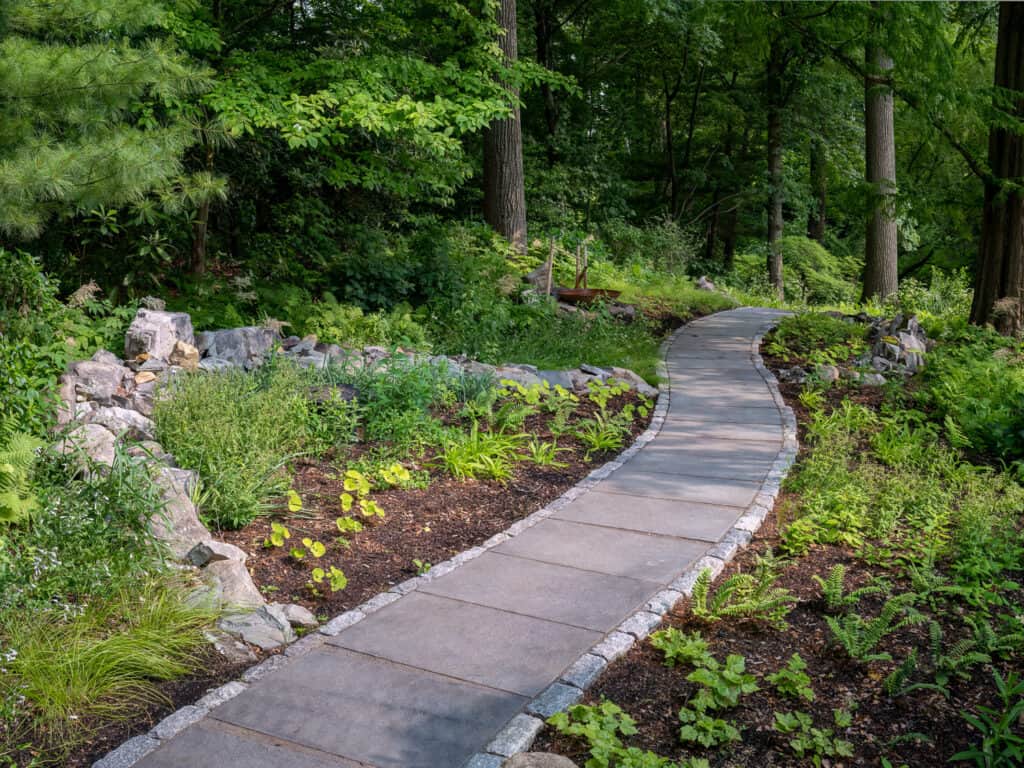
Enjoy the Beauty and Functionality of your New Walkway
Designing a beautiful walkway for your home is an exciting and rewarding project. By considering the factors discussed in this guide, you can make informed decisions and create a walkway that perfectly complements your home’s architecture and landscape.
Contact us today to start your next walkway project on the Main Line!
